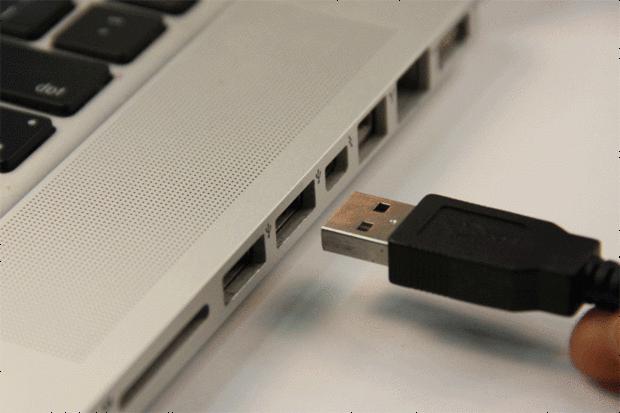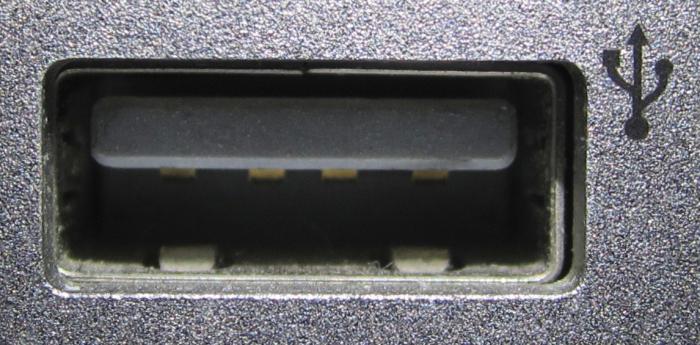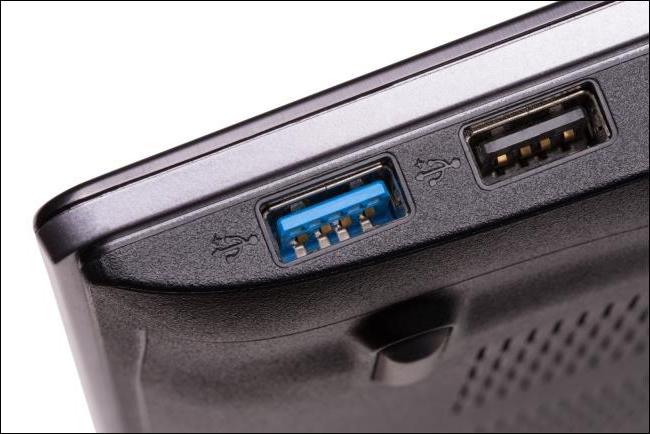Many computer owners still remember the days when all peripheral devices connected to the system units via serial (COM) and parallel (LPT) ports. The standards were quite simple to implement, which had the most positive effect on the cost of motherboards and external equipment using these interfaces. Their disadvantages were the inability to connect peripheral devices “on the go” without turning off the power of the system unit, as well as low bandwidth. However, this was a kind of payment for "cheapness", and before the beginning of the multimedia era, no one paid attention to these features . With the beginning of the active spread of multimedia technologies (digitization and transmission of voice, images), it was necessary to think about replacing COM and LPT. The result of the work of several large companies was the appearance in 1996 of the first version of the USB interface (universal serial bus), which allowed scaling in speed and supported hot Plug & Play. Since then, several generations of the standard have changed, and version 3.0 is being actively promoted. Unfortunately, despite all the efforts of the developers and versatility, until now, many owners of computer systems sometimes notice that USB ports have stopped working. And for no apparent reason. What is interesting: the USB port device is very simple: there are only 4 wires in the plug (sometimes 5, the fifth is a screen), two of which transmit data, and the remaining two are used for power supply.

Repair or maintenance
Everyone knows that to ensure the smooth operation of electrical appliances, it is necessary to periodically perform an audit. The washing machine should be cleaned, dust should be removed from the ventilation grilles of the TV, and the mobile phone should be charged and cleaned of unnecessary programs. But the computer, as a rule, is a “thing in itself”: after installing the system unit, it is often kicked under the table, the radiators are not cleaned, and very few people have heard of the fact that oil fans should be added to the bearings at least occasionally. Is it any wonder that the time comes when the USB ports suddenly turn off? Fortunately, in 90% of cases, it is possible to restore working capacity independently, without going to the service center and unplanned costs.
Basic input and output system
If there is any malfunction in the serial universal bus, you need to check the settings in the motherboard configuration program. It is present in both portable and stationary computers: it performs testing of key blocks and initial configuration of operating modes, including the ability to lock USB. This program is called BIOS (basic input / output system). In modern systems, UEFI replaced it, but the basic principle of operation has been preserved. Obviously, every computer owner is simply obliged to know how to include USB ports in the BIOS of the motherboard. Otherwise, a minor glitch or someone’s joke - and you have to go to the service center, although everything can be solved independently in literally a minute.
Board configuration
To get into the BIOS, you must immediately press the Delete button many times after turning on the system unit . On laptops, this function can be assigned to F2, which is reported on the screen with the logo (by pausing, you can read the inscription).
Unfortunately, talking about how to enable USB ports in BIOS, we cannot describe the exact algorithm of actions, because, depending on the implementation of the configuration program, the placement of items will vary. The user should “walk” through all the branches of the menu, looking for control of the USB controller, or take a book of instructions for the board and use it to find a link to this item. So, if the USB ports stopped working, then on some boards you need to open the Advanced BIOS Features and find the USB settings. By pressing the Enter line, you can select the Enabled / Disabled or On / Off status. Use must be authorized. On other motherboards, go to the Integrated Peripherals point and find OnChip USB Controller. Status - Enabled. It is also useful to verify that Legacy USB Support is also involved. So, to summarize the BIOS: the user’s task is to activate the universal serial bus controller.
Operating system registry
Windows allows you to prohibit the use of ports at the software level by changing only one digit in the settings. However, this only works for devices that have already been connected to this computer, and drivers for USB ports have been installed for them. To prohibit / unblock the bus:
- press the Win combination (button with the "windows" symbol) + R;
- in the appeared line type regedit (execute);
- follow the branches to HKEY_LOCAL_MACHINE \ SYSTEM \ CurrentControlSet \ Services \ USBSTOR;
- find the Start line and double-click the value to change from 4 to 3. This is the normal mode of operation. Changing the three to four, on the contrary, will prohibit the use of USB.
Changes will become noticeable after a reboot. We do not recommend to “play” with this item without the need, as there may be problems with the mouse and keyboard connected to the corresponding connectors.
Connecting USB ports on personal computers
For the convenience of working with the system unit, some of the connectors are displayed on the front panel of the case. In particular, these are jacks for speakers / microphone and USB. Indeed, it is very convenient when connecting the appropriate peripherals not to look for a free connector on the back of the system unit, but to use easily accessible sockets. At the same time, such an implementation has a drawback, namely, that the USB ports of the front panel are connected using a cable stretched inside the case to the comb of contacts on the motherboard. Hence the problems. The USB cable should not be made of penny conductors, as cheap cases of Chinese origin sin, but fully comply with the requirements for resistance, soldering / crimping quality, length, etc. The connectors on the back are directly soldered to the board and, as a result, are more reliable .

So, if the USB ports on the front panel of the PC system unit have stopped working, you need to remove the case cover, find the USB comb with a connected cable (signed) on the board, carefully disconnect the pins and plug and reconnect. Sometimes simply reconnecting to a neighboring comb is very effective. For example, if the cable went to USB 5-6, then you need to connect it to 7-8.
By the way, the problem with the front panel connectors is one of the most common. If there is no time to open the case, then the periphery can be connected to the sockets on the back wall.
“Eat Served,” or Food Problem
Although the specification for the universal serial bus indicates that the maximum current per port is 500 mA for the second version and 900 mA for the third, this does not mean that you can simultaneously connect devices with this consumption to all the connectors, and everything will work. Moreover, this is the shortest way to problems and the question "why did USB ports stop working." All modern boards contain an integrated universal bus controller, which, in simple terms, controls all the corresponding connectors. Physically, this is an electronic device that has the ability to directly access memory with an assigned interrupt and is able to partially free the central processor from the routine operations of sending data streams. With a large number of controller ports, there can be several. The more devices connected to the branch, the higher the current load on the controller. And upon reaching a certain value, a banal lack of power begins, which manifests itself in failures, failures of connected devices and even the controller's failure due to overload.

By the way, a USB cable bought on the market for a penny, with which some “powerful” device is connected, can have significant internal resistance, which worsens the power situation. A connected peripheral component may simply not work properly due to voltage loss in the conductors of a poor-quality cord.
Thus, if, for example, the USB port of the printer does not work, then you need to make sure that you are using a communication cable of the appropriate quality, and that no other device is connected to the nearby connector on the board. So, almost certainly there will be problems due to power supply, if the printer is included in one port, and an external DVD (without its own unit) in the next one, well, and the Wi-Fi transmitter or, which is really bad, a hard drive in the third.
How to overcome the current limit
It is impossible to “force” the controller to pass through itself a current greater than the one for which it is designed. Therefore, in case of failures in the operation of peripheral USB devices, you can go in several ways:
- distribute the components into different controllers, that is, connect the printer to another connector that is adjacent to the empty one;
- connect the most “gluttonous” devices to USB 3.0 ports;
- use an external hub with active power. This device is an analogue of a tee for the mains (branches the lines). It is connected to a free USB port of the computer, power is supplied to it from its own source, and all other peripherals are connected to the ports on the hub. A very convenient solution. The disadvantage is that you need a free outlet and additional money to buy.
A driver is not a luxury ...
Now on the market there are many boards in which, in addition to USB 2.0, there is a newer standard - 3.0. Moreover, although it is indicated about backward compatibility of versions, this is not fully implemented. The USB port device is such that for operation it is necessary to install a driver in the operating system. One time. This is a requirement. Thus, if the owner of the computer plugs the USB 2.0 device into the port connector of the third version, but at the same time forgets to install the management software package for support, then no one guarantees normal operation.
Contact Issues
There are four spring-loaded copper tabs inside the USB bus plugs. It is thanks to them that there is contact with the contact pads in the connectors. With frequent use, the contact is broken and failures begin. To solve the problem, you need to use the needle to return the bending arc of the reeds or replace the interface cable with a new one.
Cleaning the inside and outside of the system unit
Very often the computer looks clean outwardly, however, whole dust deposits are found inside the case. Port connectors are also subject to contamination. Household dust does not conduct current. Therefore, if the USB port has stopped working, you need to thoroughly clean the connector by blowing dust with a douche. It must be remembered that external and internal purity are two different things. The system unit requires periodic inspection with cleaning and purging.